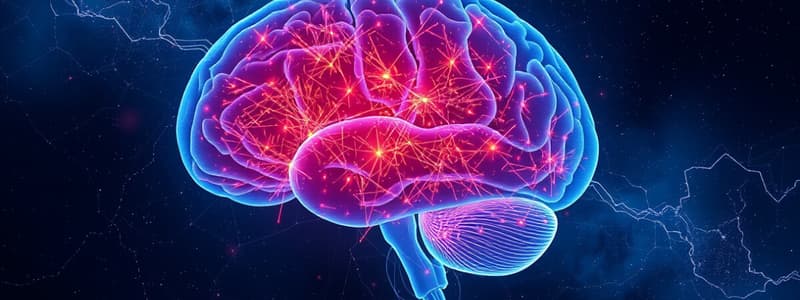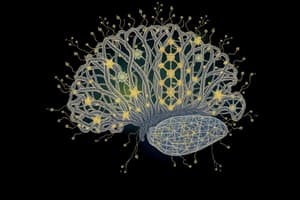Podcast
Questions and Answers
What is the purpose of dentate gating in non-epileptic animals?
What is the purpose of dentate gating in non-epileptic animals?
- To limit the propagation of seizures to protect cognitive functions. (correct)
- To increase action potentials in dendritic cells.
- To facilitate high levels of neuronal excitability.
- To enhance the propagation of seizures from the entorhinal cortex.
What is one significant difference between focal-onset and generalized seizures according to the classification system?
What is one significant difference between focal-onset and generalized seizures according to the classification system?
- Generalized seizures engage long range brain networks. (correct)
- Focal-onset seizures are classified by the region of onset.
- Focal-onset seizures are primarily associated with genomic mutations.
- Focal-onset seizures are less responsive to surgical ablation.
What alteration is observed in dentate gyrus circuitry in epileptic patients?
What alteration is observed in dentate gyrus circuitry in epileptic patients?
- Loss of mossy fibers in the molecular layer.
- Decreased frequency of action potentials.
- Formation of collateral connections among DGCs. (correct)
- Increased excitability of DGCs.
Which factor does NOT contribute to the diminished dentate gating seen in some patients?
Which factor does NOT contribute to the diminished dentate gating seen in some patients?
What role do mossy cells of the dentate gyrus play in seizure modulation?
What role do mossy cells of the dentate gyrus play in seizure modulation?
Which neural pathway is primarily involved in cognitive functions such as memory encoding?
Which neural pathway is primarily involved in cognitive functions such as memory encoding?
How does optogenetic inhibition of DGCs affect electrographic seizures?
How does optogenetic inhibition of DGCs affect electrographic seizures?
What is the primary role of the perforant path in the hippocampal circuitry?
What is the primary role of the perforant path in the hippocampal circuitry?
What consequence does increased excitability of DGCs typically have in the context of epilepsies?
What consequence does increased excitability of DGCs typically have in the context of epilepsies?
What characterizes the hippocampus in the context of focal-onset seizures?
What characterizes the hippocampus in the context of focal-onset seizures?
Flashcards are hidden until you start studying
Study Notes
Hippocampal Focal-Onset Seizures
- Epilepsy classification by Fisher et al. (2017) does not categorize focal seizures by presumed onset region due to findings that these seizures involve wide-ranging brain networks.
- Focal epilepsies, particularly those starting in the mesial temporal lobe, respond well to targeted surgical interventions, unlike generalized epilepsies.
- The chapter emphasizes understanding the mechanisms that lead to excessive and hypersynchronous discharges in the hippocampus during seizures.
Neuronal Signaling
- The hippocampus features a "trisynaptic circuit" pivotal for neuronal signaling comprising:
- Perforant path projections from the entorhinal cortex to dentate gyrus granule cells (DGCs).
- DGC axons (mossy fibers) projecting to CA3 pyramidal neurons.
- Schaffer collaterals connecting CA3 cells to CA1 pyramidal neurons.
Dentate Gyrus
- In healthy, non-epileptic states, DGCs exhibit low excitability, leading to minimal action potentials during perforant path stimulation, a phenomenon known as "sparse activation," crucial for memory-related functions like encoding and pattern separation.
- DGC sparse activation acts as a barrier to seizure propagation from the entorhinal cortex to the cortex, known as "dentate gating."
- Research shows optogenetic manipulation of DGC activity can modulate seizure frequency and duration, implicating its critical role in seizure dynamics.
Mechanisms of Seizures in the Dentate Gyrus
- Investigations focus on why dentate gating diminishes in seizure conditions, highlighting that genomic mutations are not the primary factors like in absence seizures.
- Key alterations in dentate gyrus circuitry, DGC excitability, and GABAergic inhibition contribute to changes in DGC sparse activation during seizures.
Alterations
- Histological studies reveal that in humans and epileptic animals, DGC mossy fibers undergo sprouting, forming collateral connections on DGC dendrites.
Studying That Suits You
Use AI to generate personalized quizzes and flashcards to suit your learning preferences.




